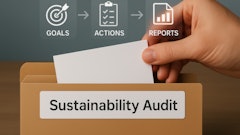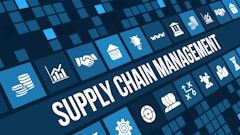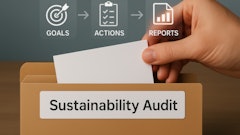
Carbon reduction matters, but service fails first when people, ethics, and accountability are weak. When these are core controls, sustainability holds through demand spikes and budget pressure.
The problem isn’t awareness - it’s execution
Freight and warehousing are significant sources of global emissions. Many leaders accept that fact, yet targets still outpace plans and measurement. Practical tools already exist, including network redesign, routing and load optimization, vehicle and facility efficiency, and selective electrification, as outlined in McKinsey’s analysis of decarbonizing logistics. When organizations anchor on those levers and track them with discipline, the gap between intent and delivery begins to close.
A second gap is people. Too few corporate goals account for safety, pay equity, training, and fair treatment across the supplier base. That omission later manifests as turnover, preventable incidents, and sudden capacity loss. The scope of the oversight is clear in the World Resources Institute’s review of 1,000 corporate goals, which found that only a small share of companies include people-centered targets, and even fewer invest in reskilling or improving working conditions.
Measurement is the third weak point. Scope 3 estimates often rely on partial or inconsistent inputs. Poor data leads to poor choices and slow progress. Recent findings from MIT’s study on supply chain sustainability indicate that most companies are maintaining or increasing their efforts, but many still lack decision-grade data, particularly for supplier emissions.
What works: manage sustainability with the same routine that governs quality and safety. Maintain a consistent cadence, track a limited set of key indicators, publish results, and assign a named owner to each measure.
Run sustainability like quality
Keep the process simple. Say what will be done, do it, and show the evidence. Use a one-page, quarterly report that a dispatcher, driver, plant manager, and CFO can all read in one minute. Keep the list concise, factual, and directly related to service and cost.
What to report every quarter
● People and safety: voluntary turnover, internal promotions, time to close grievances, completion of required training, near-miss reporting, and recordable-incident trends. Early signals lower risk and reduce cost.
● Ethics and supplier health: substantiated hotline cases and closure time, supplier code-of-conduct signatures, audit findings and time to close, and corrective-action recurrence. These indicators show whether standards are met at each lane and facility.
● Environment with evidence: fuel efficiency, route and load optimization impacts, facility energy mix, and verified waste diversion. Tie each measure to cost to serve and on-time performance. The abatement menu in McKinsey’s decarbonization work helps teams select the next practical step.
This routine converts abstract goals into actionable tasks and facilitates seamless handoffs when leaders change or markets shift.
View suppliers as partners
Most emissions and many people outcomes sit with carriers, warehouses, and service providers that do not report to you. One-way audits rarely change results, but partnership does. The WRI guidance on people-centered supply chains highlights how few goals account for supplier needs, which is a major reason checklists do not translate into better performance.
Make support the default
● Provide hands-on help: send a small team to coach smaller partners on safety programs, payroll clarity, documentation, and training. Track time to close each gap and whether it returns.
● Pool buying power: bundle energy and equipment upgrades to enable smaller firms to access fair terms. Track adoption and the change in actual energy use and incident rates.
● Route with safety in mind: factor a supplier’s safety record and staffing stability into routing and mode decisions. Paying slightly more for a reliable lane is often cheaper than a disruption.
Partnership requires clear timelines, shared investment where needed, and regular reporting. Done well, it enhances service, reduces waste, and fosters trust across the network.
Make candor a service standard
Teams move faster when facts surface early. Require same-day exception notices that state what happened, why it happened, and what is being done next. Review that information next with the safety data department each week. Close the loop with customers in writing. This habit reduces repeat issues and improves reliability in expedited, cross-border, and other high-variability operations. It also strengthens the governance and measurement discipline that MIT’s research calls out as a common gap.
Connect climate to operations and finance
Build a baseline from live systems such as TMS, WMS, and telematics. Use that baseline to evaluate changes in empty miles, utilization, dwell time, and energy use. Prioritize steps that reduce emissions while also improving service. Practical examples include route and stop consolidation, tighter trailer and container utilization, facility retrofits with clear payback, and driver support that reduces turnover. For sequence and scale, use the levers summarized in McKinsey’s decarbonization framework.
When finance, operations, and sustainability reference the same numbers, leaders can make informed tradeoffs, set realistic timelines, and report progress clearly.
A 12-month plan any shipper can audit
- Publish the one-page report. Start with six to ten measures across the following areas: People and Safety, Ethics and Supplier Health, and Environment. Name owners and list one improvement priority for the coming quarter.
- Run a network and routing review. Target empty miles, utilization, dwell, and mode mix. Track emissions per load and cost-to-serve together, using the levers identified by McKinsey to guide the roadmap.
- Fund two supplier pilots. Launch one safety pilot focused on training and near-miss reporting, and one energy or efficiency pilot, such as pooled renewable power or lighting and HVAC upgrades. Ground the approach in the people-first principles from WRI’s analysis.
- Make candor standard practice. Require same-day exception reporting to customers, including the root cause and corrective action, and then track closure speed and recurrence. Review results at the start of each week, alongside safety metrics that align with the governance themes outlined in MIT’s findings.
Why this matters now
Demand for sustainable logistics is rising while budgets and attention shift. The companies that prioritize people, ethics, and verifiable results in everyday management will maintain steady service, reduce waste, and mitigate risk. This is not a campaign or a slogan. It is the disciplined way to run a modern supply chain.



















